
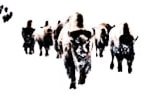
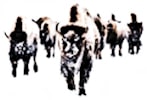

The old story of those fundamentals of the fur trade, trap-lines and dried fish, has changed in Northern Saskatchewan.
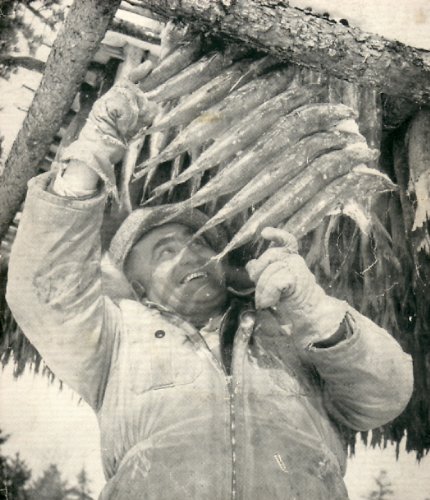
H.B.C. employee hanging fish for dog food.
The changing aspect of business in the fur trade is illustrated by the group of posts between Ile a la Crosse Lake and Methy Portage in northern Saskatchewan. At first forts were established in good trapping country. When Peter Pond travelled this way in 1778, he got twice as many furs as his canoes could carry. (He stored the surplus in a winter hut and they were collected next season.) The North West Company occupied the country and pushed on to the fur-rich Athabasca lands. This route into the northwest then became of great strategic importance, for it was estimated that half the profits of the N.W. Company came over Methy Portage. Making a late start, the H B C decided to go after the Athabasca furs and they put up a series of posts close to those of their rivals. There was much strife and by 1820, when George Simpson went up to take charge of Fort Wedderburn (opposite the rival Fort Chipewyan), the NorWesters had driven "the English" from the Ile a la Crosse district. After the union of the companies in 1821, attention was concentrated on gathering in the wild furs and keeping an adequate supply of trade goods available. With the coming of settlement, the post became a general store, which is now, in many places, its main function. The trapper is still active, but fishing may be as important a business as trapping, and the fur farmer ranks high in the production of pelts. Farms yield the bulk of the highest priced furs and have steadier production than cyclical wild life. Values in furs change. The once supreme beaver takes second place to the muskrat, and today mink, wild and farmed, is the most valuable fur crop in Canada. Time was when the fox held a high place for in a price list of furs at Fort Garry in 1860, a silver fox pelt was worth forty times as much as a mink pelt. Ninety years later a silver fox had not much more than half the value of one mutation mink. Foxes were the first fur-bearers raised in captivity and until 1940 were the most numerous. Since then mink have far outstripped all other farmed furs. With the increasing popularity of mink, the prairie provinces took the lead in fur farming. In 1951, the value of all mink pelts sold amounted to more than fourteen and a half million dollars, the value of animals and pelts sold from farms being nearly eleven million dollars. In localities like northern Saskatchewan, commercial fishing supplements fur farming. With means of rapid transportation available, shipping of fish has become a big business, and now local plants fillet, package and freeze fish, so that it is a summer as well as a winter industry. The waste from the fisheries provides good feed for the fur farm animals, apart from the fishing that is done just for mink food. Mr. J. Ross, manager R.F.D. Edmonton, tells us about the mink ranching and fishing today. He writes:
Mink Ranching
Northern Saskatchewan is quite active in the mink ranching business. It is a very suitable locality because of the abundance of fish and the economical cost of feeding mink, whereas the southern rancher has to depend on the packing houses for feed. As several of these northern ranchers are ex-commercial fishermen and trappers, fishing for mink food to these men is second nature. A notable pioneer in mink ranching is a former trapper, Mr. Halvor Ausland. At Deep River, between Ile a la Crosse and Buffalo Narrows, Mr. Ausland has one of the outstanding ranches in Western Canada, where he pelts very fine mink of the latest types. Mr. Ausland has passed on his knowledge and stock, which he purchased from the U.S.A. and from successful ranchers in Canada, to his neighbours in the Buffalo Narrows and northern Saskatchewan in general. These breeders are no longer content to raise inferior or poor types, and their mink have improved in quality tremendously during the past five years. Field Days, big event of the year at Big River, Meadow Lake, Waterhen Lake and Buffalo Narrows, are well attended. The Field Days are small shows where local ranchers exhibit their mink to be graded by a competent judge, and ribbons or prizes are awarded to the winners in various classes. A few years ago ranchers from the southern part of Saskatchewan brought mink up for show at these, northern Field Days and more or less dominated the prizes. In recent years this has changed and we now find the boys from the north more than holding their own with their southern brothers. These Field Days have been very helpful in improving the stock of the fur farmers, and they have been good business for the southerners who sold their mink in the north for good prices. We understand, however, of late, that some of the ranchers in the south are buying mink from the northern farms There is wonderful feeling of goodwill in these transactions and a lot of credit has to go to the Saskatchewan Mink Breeders Association for fostering Field Days and exchange of animals and ideas between the ranchers. Ranchers who have been content to raise inferior dark mink now find themselves in the difficult position of having to take less money for this type of mink. With the cost of operating, due to feed and equipment, being higher than a few years ago, it is doubtful whether this type of fur farm can last much longer. The majority of the people in northern Saskatchewan in the business are breeding the mutation type of mink which are presently selling more or less at the old levels. Regardless of how difficult the mink market may be for the next year or two, these people, we feel certain, will survive these bad times and will carry on in the mink business for years to come. Mink ranchers in northern Saskatchewan can be considered pioneers, like our homesteaders on the prairies of a few years ago; they have had set-backs to contend with before and have successfully overcome them. It is interesting to note that a point such as Buffalo Narrows can lay claim to the fact that the mink industry has made it a town or village of any consequence at all. Other points such as Ile a la Crosse, Dore Lake, Smooth Stone Lake, and Waterhen Lake where mink farming is carried on in northern Saskatchewan, have all played their part in the development of the country due to the mink industry. 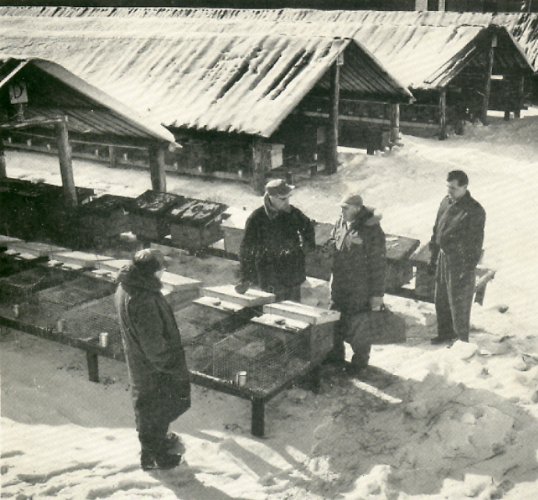
(L-R) Richie Calder, Mr. Vickland of Churchill Mink Ranch, Buffalo Narrows.
W.J.Cobb and Post Manager Steve Preweda 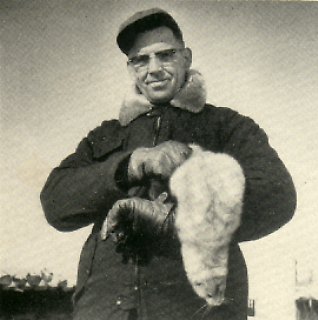
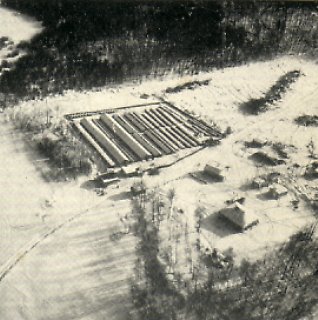
(Left - Mr. Vickland with a fine mutation mink
Right - A large mink farm seen from the air
Fishing in Northern Saskatchewan
The commercial fishing in northern Saskatchewan is divided between government operated plants and smaller privately owned operations. The largest of the private concerns is Waite Fisheries operating out of Big River under the management of Mr. Len Waite. Mr. Waite has a large filleting plant at Buffalo Narrows and fillets several tons of fish each year. Whitefish for export to Eastern Canada and the United States is the big commodity. These fish are filleted, packaged and frozen at Buffalo Narrows in the summer, taken by barge to a loading point at Ile a la Crosse where they are trucked to Big River and there put in refrigerated cars for eastern delivery. This plant at Buffalo Narrows also handles trout, and the so-called Winnipeg goldeye which are flown in from a northern lake where they are processed and frozen for shipment to Winnipeg for smoking. Several of our Saskatchewan posts buy considerable quantities of fish for the Waite Fisheries in the winter time. These fish are collected on the lake from the fishermen by snowmobile. Loads are picked up at the posts by cat swings and hauled into Big River. Sport fishing in northern Saskatchewan is second to none, Lac la Ronge being the most accessible and popular point. A very good road from Prince Albert to La Ronge has paved the way for Americans in their Cadillacs who arrive at Lac la Ronge in goodly numbers. The more prosperous fishermen hire commercial aircraft out of La Ronge. Others can rent boats and accommodation for trout fishing and other types of sport fishing right at La Ronge. To the north of Lac la Ronge there is an abundance of grayling and this type of fly fishing has been given quite a play during the past few years. The influx of fishermen has given a very good livelihood to the Metis of this area who are hired as guides. The very good wages paid have helped the economy of these people considerably during the past few years. Lac la Ronge is certainly not the only fishing spot in northern Saskatchewan but it is a good centre. As the country opens up, lakes to the north no doubt will be given more attention. Other good sport fishing lakes are Loon Lake, which is a summer resort, Cochin Lake, and Candle Lake. Incidentally, Candle Lake, 70 miles north and east of Prince Albert, is to be the site for the proposed Saskatchewan pulp mill. 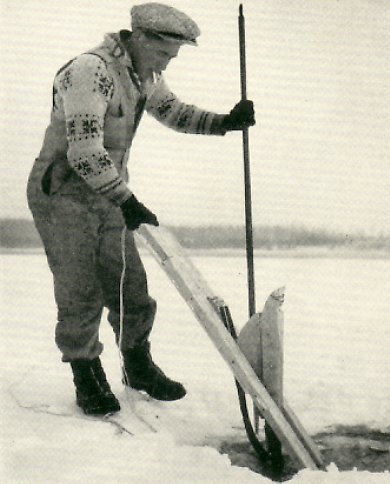
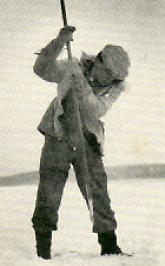
The fisherman makes a hole through the ice at
Patuanak with his ice chisel (needlebar) The jigger is put into the water, to creep beneath the ice and be taken out through another hole. 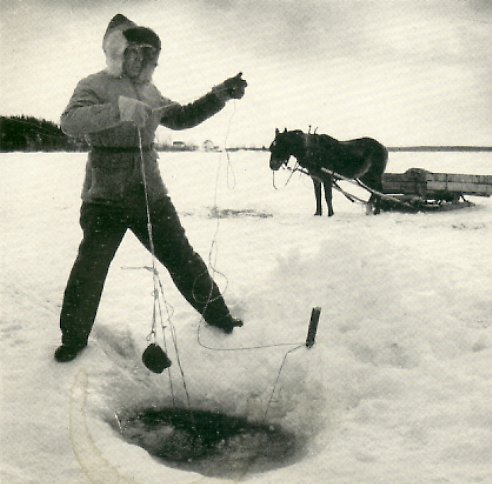
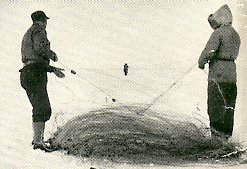
A line has been taken below the ice by jigger
and now the fish net is pulled in Peter Pond Lake, with what is called a running line. One man takes either side as they pull the fish net out from the frozen lake. 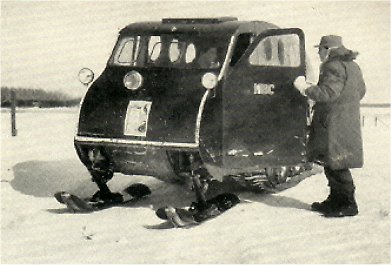
The snowmobile has many uses as a transport.
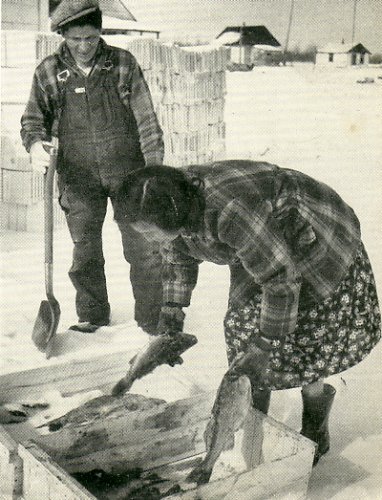
At Patuanak, fish is packed to be taken out by tractor swing.
The Indian holding the shovel also drives the Company snowmobile. 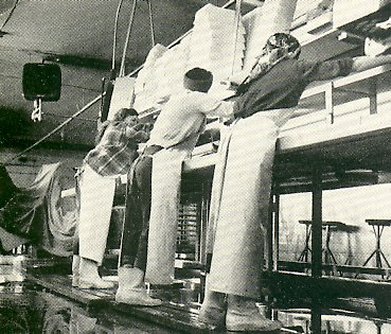
Girls packing fish in the Waite Fisheries plant at Buffalo Narrows.
|
| The Manager's Tale | Sakitawak | Lost Land of the Caribou | Lefty McLeod |
| History of Buffalo Narrows | George Greening | Big River | Bill Windrum |
| Face the North Wind | North to Cree Lake | Dore Lake | George Abbott |
| These are the Prairies | Links Page | Sask. Pictorial History | Joe Anstett |
| A Century in the Making | Wings Beyond Road's End | Photo Gallery |
